Table of Contents
According to a recent study by PwC, nearly 32% of customers would consider severing ties with a beloved brand after just one negative encounter. This statistic underscores the critical importance of every interaction between businesses and their clientele.
A single misstep has the potential to alienate a sizable portion of your loyal customer base.
Now, with the rise of artificial intelligence, it’s easier than ever for businesses to improve the customer experience and increase average customer lifetime value.
But how exactly does AI elevate customer interactions? And in what ways does this advanced technology transform ordinary engagements into memorable experiences, fostering loyalty and driving business growth?
If you've found yourself pondering the impact of AI on customer experience, this blog post is tailor-made for you.
But before diving in, let's understand what AI brings to the table for customer experience.
Role of AI in customer experience
AI has revolutionized numerous sectors, and customer service is no different.
In the past, conventional customer support frameworks struggled with managing high volumes of inquiries, resulting in frustrating experiences for customers and undue pressure on support teams.
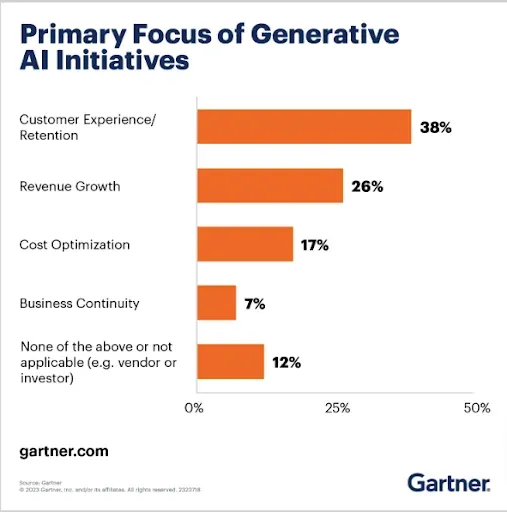
As customers, we've all faced these common hurdles when seeking help from a service provider's support team:
- Waiting for ages on hold, either on the phone or in a chat queue.
- Dealing with representatives who don't seem to have the right answers or information.
- Having to repeat our problem over and over, especially if we get disconnected.
- Waiting forever for an email response or confirmation email.
- Getting vague or cookie-cutter replies that don't really address our questions.
- Finding no help available when it's outside of regular business hours.
However, AI-powered systems can handle a large volume of customer inquiries simultaneously and provide quick and accurate responses 24/7. This not only ensures that customers get the support they need promptly but also lessens the workload on support teams, allowing them to concentrate on more complex issues.
Because of these valuable capabilities, Gartner predicts that by 2025, AI will significantly change how 80% of customer service and support organizations interact with customers.
Top 9 strategies for improving customer experience in the age of AI
AI has reached a stage where it can assist companies in comprehending, reshaping, customizing, and refining their customer journey.
To illustrate the impactful role of artificial intelligence in customer experience, here are some practical strategies. This rundown provides insight into what's achievable today by integrating AI into customer experience as well as its potential for the future.
1. Utilize AI-driven customer data analytics for personalization and predictive insights.
Companies nowadays leverage AI to delve into customer behavior, demographics, and preferences, tailoring their offerings to enhance the onboarding process.
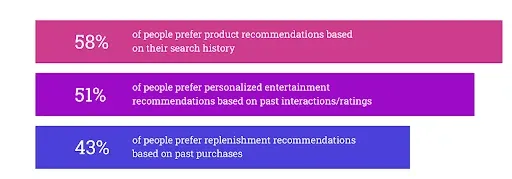
Netflix stands as a prime example of this approach. The streaming giant utilizes AI to curate a personalized home screen for each subscriber. Upon sign-up, viewers are prompted to select their favorite movies and TV shows.
Leveraging AI algorithms, Netflix then delivers recommendations for similar content and continuously refines its suggestions based on viewing habits, duration, and device usage.

Similarly, Amazon harnesses AI and machine learning to comprehend the context behind user queries, ensuring the most relevant search results. Drawing from past search history, Amazon also suggests similar items that may pique customer interest.
Moreover, the company offers a personalized shopping service for Prime members, where style preferences are gathered through a survey, and consultants curate custom clothing selections.

Personalized experiences not only expedite the fulfillment of customer needs but also foster a sense of satisfaction that encourages repeat engagement.
- Utilize data to tailor survey questions.
- Employ geolocation technology for location-based personalization.
- Provide recommendations based on past purchase history.
- Adapt website content dynamically according to user preferences.
2. Implement AI-powered chatbots and virtual assistants for instant support.
Expanding into global markets demands consistent support to ensure top-tier customer satisfaction. Implementing AI-powered chatbots enables customer service teams to offer convenient 24/7 assistance with in-app support.
Natural Language Processing (NLP) empowers virtual agents and chatbots to understand spoken language and respond based on set criteria. Unlike rule-based counterparts, AI algorithms can grasp context, simplifying issue identification and suggesting appropriate actions, like connecting customers to live agents when needed.
The adoption of chatbots not only enhances the overall customer experience but also leads to quicker response times and reduced customer service expenses.
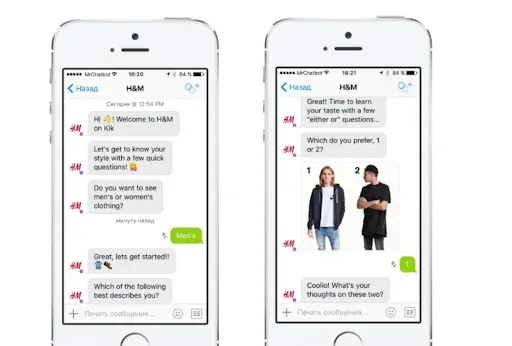
Take H&M, for example. The brand uses chatbots for quick answers on product specifics and order tracking.
Similarly, Domino’s Pizza employs chatbots to handle orders and respond to inquiries regarding their menu, delivery options, and payment methods.
3. Enhance self-service options with AI-driven portals and voice recognition
With the rise of virtual assistants like Siri, Alexa, and Google Assistant, using voice for customer support has become increasingly popular.
These AI-powered voice assistants offer immediate assistance to customers, making it easier for them to get help without having to navigate through complex menus or wait for a human agent.
They use advanced voice recognition technology to understand and accurately transcribe users' speech, enabling seamless interaction and response to inquiries in natural language. By taking care of tasks such as password resets, appointment changes, and order status inquiries through casual conversation, these bots ensure swift and hassle-free issue resolution.
For example, many healthcare providers now use voice assistants to offer patients medical information and reminders for upcoming appointments.
4. Analyze real-time customer feedback using AI-driven surveys and act on it promptly.
The impact is high when customers voice their experiences. Understanding their thoughts and feelings when they directly respond to surveys, for instance, assists in better decision-making in customer experience.
But, of course, one-on-one chats with each customer would be time-consuming. It's not feasible to ask all your customers about their brand perception and patiently await their responses.
Limited by the historical variability, companies just had very little natural language feedback that they could process and use.
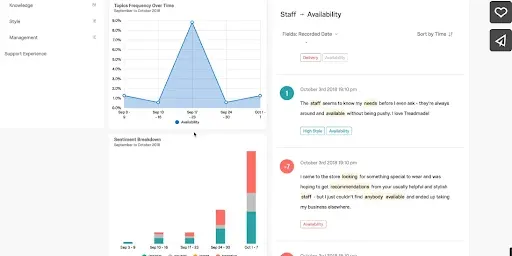
Fortunately, technology has bridged this gap by enabling the analysis of feedback from customer surveys on a large scale. Tools like Text iQ leverage natural language processing to sift through extensive written feedback, uncovering key patterns crucial for understanding. Moreover, they can provide predictive insights based on your data.
Companies such as Apple constantly gather public opinion by using the Net Promoter Score (NPS) to assess customer loyalty.
5. Achieve accuracy in marketing strategies
Let's start by discussing the efficiency of ad costs. With the help of AI, businesses can gain a deeper understanding of what their customers prefer. As a result, marketing initiatives can focus on groups of people who are more likely to convert, reducing resource waste and increasing return on investment (ROI).

By leveraging AI's capacity to analyze different data points like demographics, interests, behaviors, and locations, organizations can refine their customer segments.
When combined with predictive analytics, this combination becomes a powerful tool for crafting highly targeted digital marketing and advertising campaigns that resonate with specific market segments.
AI also revolutionizes the A/B testing of ads by integrating with AI-powered solutions like MMM (Marketing Mix Modeling). This allows businesses to move beyond manual testing and assess various ad versions while considering the broader impact of marketing channels and tactics on key performance metrics.
Leveraging AI capabilities provides deeper insights into ad campaign performance, empowering businesses to optimize strategies more effectively.
This shift towards AI-driven optimization ensures efficient utilization of advertising budgets, resulting in enhanced ROI and overall campaign success.
6. Use AI for predictive maintenance and proactive communication with customers.
Harnessing the power of AI to enhance customer experiences extends beyond just reacting to feedback—it's about understanding and anticipating their needs.
By delving into transactional data, usage patterns, and survey responses, AI can uncover valuable insights into customer behavior trends—such as repeat purchases, churn risk, and reactions to new offerings.

The ability to accurately predict customer intent is a game-changer for businesses.
In simple terms, foreseeing potential pain points in advance equips businesses to better retain their customer base.
Take, for instance, how an airline might utilize predictive analytics to gauge the impact of price adjustments or schedule changes on demand for different routes.
Similarly, a subscription-based company could analyze usage patterns to identify customers showing signs of disengagement and proactively offer incentives to keep them on board. It's all about staying one step ahead to deliver a seamless and satisfying customer experience.
7. Employ emotional AI to understand and respond to customers effectively.
A survey found that
That’s where natural language processing (NLP) steps into the spotlight, making it possible to swiftly analyze large volumes of unstructured text data.
Through sentiment analysis, it uncovers vital themes and actionable insights, offering invaluable avenues for refining products and services.
Imagine having a tool that pinpoints exactly what your customers love and what they don't about your brand. That's the power of sentiment analysis software. It sifts through customer feedback services, providing targeted metrics on both the positive and negative aspects of your business.
For instance, businesses like AirBnB can leverage social media sentiment analysis to dive into customer reviews, pinpointing areas ripe for improvement.
This kind of analysis isn't just about understanding feedback; it's about shaping your brand image and fostering customer loyalty. By delving into sentiment analysis, businesses can uncover the factors influencing customer retention rates and brand loyalty.
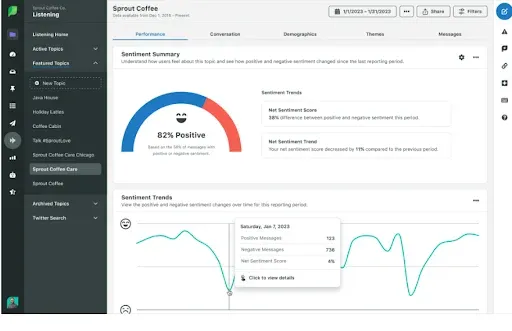
8. Prioritize data security and privacy in AI-driven customer interactions.
Absolutely, the allure of leveraging AI for enhanced customer engagement is undeniable. However, amidst this excitement, it's crucial to address a paramount concern: Customer Data Privacy.
In today's scenario, where data is the lifeblood of AI systems, consumers rightfully demand utmost care around their personal information.
Therefore, to establish and fortify trust, brands must make safeguarding customer data a non-negotiable priority. This entails implementing robust privacy protocols and rock-solid data security measures.
To achieve this, companies should aim for zero- and first-party data, meaning data collected directly from customers or through their interactions with the company. But it's not just about gathering data; it's about doing so responsibly.
That's where data minimization comes in. Collecting only what's truly needed for personalization shows respect for customers' privacy without crossing any boundaries.
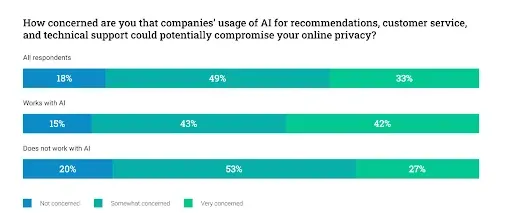
Of course, none of this matters if customers aren't aware of how their data is being used. That's why clear and easily accessible privacy policies and consent options are non-negotiable.
Customers should know exactly what they're agreeing to and have the ability to opt in or out with ease.
Collecting and sharing more complex customer information across teams can be challenging without a centralized system. This is where solutions like Content Snare come in. As a cloud-based content software, it ensures secure data collection and seamless information sharing between providers and customers.
However, for those seeking alternatives to Content Snare, exploring other platforms such as Formstack, JotForm, and Typeform can provide comparable functionalities tailored to individual needs.
Each platform offers distinct features and advantages, enabling businesses to select the solution that best fits their needs and preferences.
9. Continuously refine intelligent workflows
Moving customers around to different departments and representatives does not make for a good customer experience. AI enables you to create powerful and intelligent workflows that deliver faster customer support and more efficient agents. This eliminates wait times by intelligently connecting customers to the best agent for the job.
Support teams can use artificial intelligence to route requests to the right person based on:
- Customer intent, mood, language use
- Competence of the agent
- Agent status
- Agency skills

Imagine a scenario…
A customer calls because the price they were charged for an additional service is different from what they expected.
AI recognizes the Spanish-speaking consumer, figures out if the customer is upset by their tone and captures the customer's account type and billing information. Then, it moves on to find an available senior agent who handles billing discrepancies, speaks Spanish, completes the handover, and provides basic customer information.
How major brands employ AI to improve customer experience?
Companies are increasingly leveraging AI and ML to enhance customer experiences, and Spotify stands out as a prime example. Through innovative AI applications, Spotify continuously engages its users, provides personalized recommendations, and refines in-app search capabilities.

Spotify's discover weekly playlist.
Every Monday, it drops a personalized playlist curated by its smart algorithm, tailored to each user's unique listening habits. It's like having a musical genie that knows just what tunes you'll love next. This keeps users excited about discovering new music and coming back for more.

Then there's Spotify Wrapped, the annual highlight reel of your listening year. At the end of each year, users receive a comprehensive summary of their most-played songs, genres, and podcasts. This annual tradition not only fosters user engagement but also sparks viral sharing on social media platforms.
What's really cool is how Spotify is flipping the script on user data.
Instead of keeping it behind the scenes, they're actively involving users in celebrating their own data. It's a win-win situation where users feel more connected to the platform, and Spotify gains valuable insights to enhance their experience even further.
This level of personalization wouldn't be possible without AI.
Key takeaways
Investment in AI is expected to surge by over 300% in the upcoming year, reflecting the growing recognition of its transformative potential across industries.
With this accelerated investment, AI bots are poised to become the backbone of approximately 85% of customer service interactions.
It's clear that businesses ignoring AI might end up losing customers, falling behind in innovation, and providing slower service.
So, rather than treating AI as an afterthought, let's ask ourselves: How can AI make the customer experience better?
Well, to begin with, AI can enhance the abilities of human teams, giving companies a solid edge. But here's the thing: it's important for companies to find the right balance between AI-driven automation and the personal touch. After all, genuine emotional connections are what really keep customers coming back for more in the long run.
In navigating this balance, the expertise of an AI Consulting Company becomes invaluable. These firms specialize in crafting bespoke AI solutions that not only streamline operations but also enrich customer interactions with that crucial personal touch.
We’ll leave you with this thought to mull over:
“Predicting the future isn’t magic; it’s artificial intelligence.”


